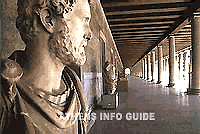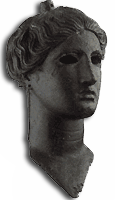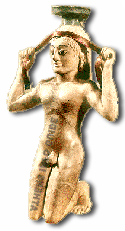
Ancient Agora Museum
(Stoa of Attalos)
The Ancient Agora Museum is housed in the restored Stoa of Attalos,
a monument dated to ca. 150 BC. The museum was restored by the
American School of Classical Studies between 1953 and 1956 to
house the finds from the excavations in the Ancient Agora. In
1957 The Greek state took over the administration and security
arrangements for both the museum and the archaeological site.
The museum’s special feature is that its exhibits are
directly related to the functions of Athenian democracy, reflecting
the role of the Ancient Agora at the heart of the City’s
public life. Among the objects associated with Athenian civic
life and dating from the 5th to the 2nd centuries BC are a 5th
century clepsydra (water clock) used to measure the time in the
law courts, 5th century ostraca (inscribed potsherds used in
voting to ostracize (expel) famous politicians such as Themistocles
and Aristeides, and 4the century bronze ballots also used in
the courts of law.
 Inscriptions from the 5th to 2nd centuries BC are also exhibited.
Among these are an inscribed stele of 337/336 BC during the period
of Phyrichus’ archonship, when the people of the city voted
a new law against tyranny. On the relief above the decree, democracy
is shown crowning the people. Also important is a marble kleroterion
(a lottery device used to randomly choose citizens for public
posts) used by the Boule (council) during the period of the twelve
tribes (3rd-2nd century BC). The military history of the city
is portrayed on an inscribed bronze shield, a trophy taken by
the Athenians after their victory over the Spartans in the battle
of Sphacteria, in 425 BC. Inscriptions from the 5th to 2nd centuries BC are also exhibited.
Among these are an inscribed stele of 337/336 BC during the period
of Phyrichus’ archonship, when the people of the city voted
a new law against tyranny. On the relief above the decree, democracy
is shown crowning the people. Also important is a marble kleroterion
(a lottery device used to randomly choose citizens for public
posts) used by the Boule (council) during the period of the twelve
tribes (3rd-2nd century BC). The military history of the city
is portrayed on an inscribed bronze shield, a trophy taken by
the Athenians after their victory over the Spartans in the battle
of Sphacteria, in 425 BC.
The Ancient Agora Museum also houses finds that reveal the commercial
life of the city such as coins from the 6th century BC to 1831
AD , official weights and measures as well as amphorae dating
from the 6th century BC to Byzantine times. The private
life of Athenian citizens is reflected in grave goods and large
amounts of household equipment, mostly pottery found in
hundreds of excavated wells. Among the most outstanding are:
•
an ivory pyxis (jewelry case) from a Mycenaean tomb (ca. 1400
BC) with a scene of griffins
attacking a deer
• a pair of gold earrings (ca. 850 BC)
• terracotta shoes (ca. 900 BC) from Geometric female
burials
• small terracotta animal toys found in a child’s
grave of the 4th century AD.
Among
the objects of private life are numerous finds from wells, deposits,
burials, workshops and shrines. They include:
•
terracotta, bronze, ivory and glass objects from the 6th
century VC to the 3rd century AD
• terracotta lamps from the 7th century BC to the 11th
century AD
•
Byzantine and Ottoman period ceramics (10th/12th to the
17th century)
Important exhibits
in the Ancient Agora Museum include various ceramic containers
from the 6th century AD, in particular an aryballos (a small
flask with a narrow neck) in the form of a kneeling athlete
who binds the victor’s ribbon around his head (ca. 530
BC), a red-figure kylix (drinking cup) by Gorgos (ca. 500 BC)
and a black-figure krater by Exekias showing a Hermes scene
(ca. 530 BC).
Around
the peristyle of the ground- and upper floors one can see statues
and architectural elements from the 6th century BC to the 3rd
century AD. Standing out are:
•
a bronze Nike head, once gilded with inlaid eyes (ca.425 BC)
• a marble statue of a winged Nike, possibly an acroterion
of the Stoa of Eleutherios (ca.
415 BC)
• a Nereid statue that is reminiscent of the style of
the sculptor Timotheos (ca. 400 BC) and
which probably
was an acroterion of a temple roof
• a fragment of a victory relief in an equestrian contest
(ca. 360 BC)
• a marble female bust (late 2nd century AD)
• a herm of a sleepy Silenus (late 2nd century AD)
The
Ancient Agora Museum has some outstanding sculptures: the statue
of Apollo Patroos, a colossal cult statue by Euphranor (ca. 330
BC) as well as the allegorical female figure of monumental dimensions,
either Themis or Democracy, set up in front of the Royal Stoa (ca. 330 BC).
On
the upper floor of the Stoa are models of the Ancient
Agora,
the Acropolis and Pnyx
Hill where the people’s assembly
met.
 Opening hours and admission
Opening hours and admission
 24, Adrianou Street
24, Adrianou Street
 Monastiraki Monastiraki
 For typical words, please consult our Greek
Glossary
For typical words, please consult our Greek
Glossary
 See
photos of the Ancient Agora
See
photos of the Ancient Agora 

|

